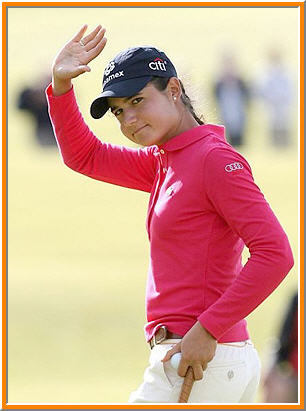Random acquaintance: I heard you play golf?
Golf Chick: You heard right.
Random acquaintance: But you’re not gay!
Golf Chick: It’s a “don’t ask, don’t tell” policy these days. Shhh.
Random acquaintance: Really?
Golf Chick: *eye roll*
And so it goes. The stereotype of female golfers being lesbians is alive and well. At least among non-golfers and people who don’t really follow the sport. But who really cares about them?:
Golf Chick: You know, the vast majority of professional female golfers are heterosexual. Can you even name a single gay player?
Random acquaintance: How about Billie Jean King?
See what I mean?
It’s no secret that there have been several gay players on the LPGA over the years. I suspect there are several gay players on the PGA Tour as well, though I couldn’t name a single one. If “a few good men” came out to the public, would that build a stereotype of male golfers being gay? Yeah, right. Football, with all its contact and soft core porn sequences couldn’t even sustain that image if a star player or two actually ever came out.
Let’s get serious
Sadly, being gay is still a stigma for professional male athletes. Hell, I think it’s still a stigma for any male, especially with such macho (and purportedly straight) athletic role models, whether or not the gay man actually looks up to them.
Is it still a stigma for women?
That’s difficult for me to answer. I can’t know what it feels like to be a lesbian or whether or not people judge you because of it. I imagine there is still plenty of that going on.
However, I think there is an element of acceptance due to a sexualized society. Guys like the idea of two women together. As long as they’re pretty, of course. And there are plenty of insecure pretty girls who crave the attention of men so much that they will alter their behavior, their actions, their bodies, and their sexual orientation to get it and therefore can’t really be judgmental of lesbians. But that’s qualified tolerance, not acceptance. Personally, I hate that the word “tolerance” is used to describe freedom from bigotry. Who wants to be tolerated?
I think openly gay women are secure with themselves and, while they might appreciate universal acceptance, don’t need it. Just like secure straight women don’t care if they’re assumed to be gay just because they play golf. I know I don’t.
Back to the lighthearted fun
I recently discussed this topic with my friend, Wendy Dexter, who specifically asked to be fully named when I told her I would write about it. She’s a whack-job free-spirited, outspoken, fun character and I love hanging around her. She does not play golf. She does not watch or follow professional golf. Just the perspective I sought.
First, Wendy said she assumed all female golfers were lesbians and that I was the exception.
Then, after more discussion and her giving it more thought, she said she guessed not all female amateurs could be gay, but that she was still certain the pros must be. And that the better amateurs probably are, too. Whaaaa? Then the conversation went something like this (though it wasn’t nearly this streamlined):
Golf Chick: So, the better the golfer, the greater the likelihood she is gay?
Wendy: Exactly.
Golf Chick: Can you be good and not be gay?
Wendy: Probably not. Wait, but you’re not bad, right?
Golf Chick: Only compared to some. So, will you become gay if you improve to a certain level?
Wendy: No, I guess not. But you probably won’t improve that much if you’re not gay.
*another round of drinks is delivered*
Golf Chick: Do you have to be good to be gay?
Wendy: Are we in a “Sex and the City” episode? That sounded like a Carrie question. I can just see you typing this up and then comes the voice over: “Do you have to be good to be gay?” Or “gay to be good?” Whichever, I think you do.
Golf Chick: Can you be gay and be bad at golf?
Wendy: Hmm… probably, you just have a better shot at being good than if you were straight.
Golf Chick: Do you have to be born gay or can you choose it in order to improve your game?
Wendy: Would you?
Golf Chick: If you weren’t f—ing with me and this had any merit, I might really consider it. Greg would probably understand.
But she was only halfway f—ing with me. She actually does assume that female pro golfers are all gay. And, she claims that belief is the majority opinion in the non-golfing community. I tend to believe her because she has more friends and connections in reality than a lot of teens do on Facebook. She’s got the pulse of the community, one could say. I assumed but neglected to ask if that majority opinion includes gay non-golfers. Note to self to follow up.
I went on to explain the current atmosphere of the LPGA Tour and how most of the top players are straight, and that some of them are even adored for their looks, sexy or wholesome.
Wendy was flabbergasted.
For the record, I’m pretty sure Wendy is straight. Though I wouldn’t be surprised if she gave women a try just to be sure. And while the stereotype may have a negative connotation for many believers, it doesn’t for Wendy. She loves everyone.
Next post.
 Moving on…
Moving on… 

 The Golfchick points proposal:
The Golfchick points proposal:


Indio, Shmindio. Try putting on the beach.
As the Kraft Nabisco (Dinah Shore) got underway today, the women of the LPGA were making and missing putts on slick, true greens in their first major of the year. The announcers just would not stop talking about the “Indio effect,” which just means the greens tend to break toward the town of Indio even if they don’t look like they will.
Meanwhile, I went out for a local round and encountered the seediest sandiest greens I’ve ever seen. Seriously, it was like putting on a beach. The bunkers there seem to be mostly hard dirt, so maybe they should reconsider how they want to use all that sand. Waaaah. I’m such a whiner. Somehow I managed to squeak in at 90 but still, I think I want my money back. This photo has not been doctored in any way.
Next post.